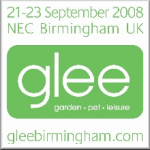Page 1The Biggies
Page 2The Mediums
Page 3The Others
Page 4Accessories & Awards
Previous Glee reviews:
Glee 2008 - Review - Page 1 of 4
Glee : it's always struck me as a strange name for a hard-landscaping show. Someone once told me that it was an acronym for Garden, Leisure and External summat, which makes sense, but however the name came about, glee (the sense of thrill) was not much in evidence at this year's Glee (the trade show).
It may have been pre-ordained by loss of the last of the major manufacturers, when Marshalls withdrew, leaving only their StoneMarket imprint to champion the brand. Over recent years we've seen Brett pull out, and Tarmac®™© in their TopPave format are no more. Indeed, Tarmac ®™© (they set their lawyers on me if I use their name in vain) in their bagged aggregates outfit didn't even bother to turn up, despite being listed in the eve-of-show exhibitor list, and their allotted space seemed to be occupied by yet more flowerpots. Hanson Formpave was absent, but then I never fully understood their mission at this show. When they were just Formpave, there was a logic to attracting new stockists, but as part of the much larger Hanson stable of building products, the relevance of Glee is diminished and a show such as next month's Interbuild seems more appropriate. Even so, it's yet another loss to the overall event.
Thankfully, Aggregate Industries in their triptych format of Bradstone-StoneFlair-Border Stone, are still with the show, but to say they were 'not happy' with this year's event would be putting it mildly. Speaking to one brand manager as the closing bell rang on Tuesday afternoon, I have never seen him so annoyed and dispirited, despite them having a fairly successful show.
Most of the dissatisfaction stemmed from pitiful visitor numbers on the opening Sunday. There was a common belief that this may have been due to the fact that the first day of autumn was also the best day of a dismal summer, and many would-be visitors had opted to make the most of the sunshine rather than spend the day in a big tin shed gawping at paving. This, at least in part, was wishful thinking, and perhaps the combined power of all those individual wishes had some impact on the cosmic forces, because Monday was a much better day in terms of footfall. That's not to say it was heaving, or even busy, but there was certainly more visitors, and, if exhibitors are to be believed, some very good quality visitors.
So what did those visitors get to see?
Stonemarket:
As I ambled along the 'back passage' of Hall 4, the first sight of this year's StoneMarket stand consisted of a white stucco wall. Not exactly welcoming, I thought, blocking visitors' access to the stand like that, but I could hardly be more wrong. If I'd had the common courtesy to approach from the 'front', all would have made sense, because that obstructing wall actually formed an essential backdrop to two stunning patio-cum-courtyard displays.
Marketing magician Tina Petty explained the thinking that had gone into these two superbly crafted dioramas: it was an extension of the 'gallery' theme currently being employed at the growing number of StoneMarket display centres. As with an art gallery, the idea is to present the work in such a way that the observer's initial viewing position is largely controlled by the exhibitor, and rather than allow free access from any direction, a carefully framed 'view' is initially presented, and only then is the visitor allowed to explore further. It's very clever, very subtle, and very, very effective.
The more the two displays are considered, the greater the appreciation. A casual glance reveals a contrast between a fairly traditional 'feature circle' Cotsdale Patio and a chic monotone courtyard, but there's so much more to it than that. The 3.2-ish metre 'feature circle patio' is centred on a de-bloody-licios Celtic Knot feature cut from contrasting Cotsdale (Kotah Yellow) limestone and Kadapha Black sandstone that Mrs Taz has already decreed will be the new patio here at Borlochs Hall. The complimentary squaring-off kit features 'spokes' that radiate from the centre, and had been 'stepped' to create a change in height, using rubble limestone to create the riser and the accompanying planter walling. A few tasteful purple-and-gold hued plants against that ice-crisp white wall and you have a simple but stunning patio.
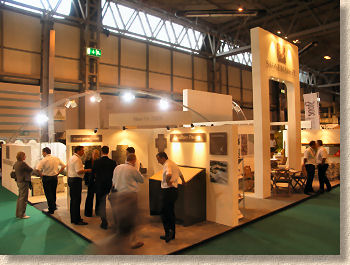
Next door, the glossy magazine stylishly cool Avant-Garde courtyard garden had been created from honed grey sandstone, and featured a motif-etched 845x560mm flagstone that seems shockingly expensive when first encountered, but when it's considered that just a few of them can make such dramatic impact on the design and styling, it is probably worth the expense. The Helix format used on the display garden is modern and quite tasteful, while the appropriately named Swirl looks too busy to my eye, although we were only shown individual units.
Etching is the next logical step in the 'adding value' processes that turn standard riven 12 quid-per-metre flags into honed-and-calibrated units costing 40-60 quid per metre. Etching can add another 20-30 quid, but the effect is exceptional.
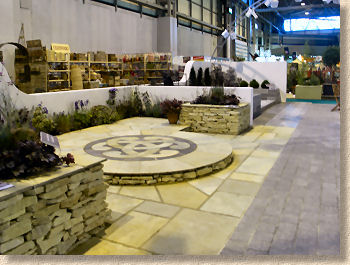
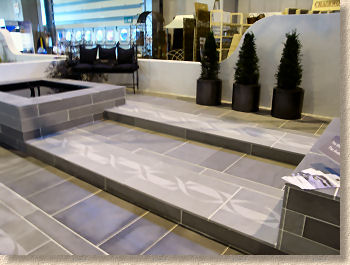
The garden styling is further emphasised by orthogonal steps, the triple-jet fountain emerging from a black pool with honed grey copings at convenient bum-height, and dark planting against that white textured wall. If there was one thing that irked, that would be the pure-as-the-driven-snow white pointing between the flagstones. Yes: it really did emphasise the stone, contrasting sharply with the neutral grey, but in a real garden, for how long would it remain white? I'd give it a fortnight before it degenerated to the standard garden grubby brown .... unless, of course, you have the staff to scrub the patio on a twice-weekly basis.
The other notable new item on show would be the Cruciform paving, yet another clever innovation from the StoneMarket thinktank. It's a cross-shaped wet-cast flag shown in a rich olive colouring although it will be available in two other (unspecified) colours. It has a highly naturalistic surface texture, in the appearance of random-laid setts, with handy T-shape and L-shape pieces to ease the creation of straight edges. The shape of the flags allows them to interlock, and the uniform thickness allows them to be laid directly onto a screeded laying course. I'd be worried that some eejit will actually think it is a block paver, and will therefore run the vibrating plate compactor over them, with obvious (to us!) consequences. Not sure about price, but a very attractive option for pedestrian-only courtyards and patios.
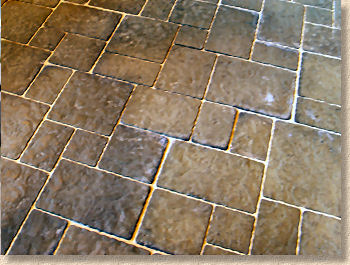
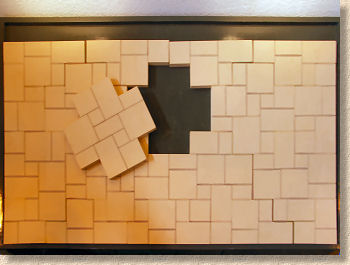
Naturally, having the manufacturing skills of Marshalls and Paver Systems at their behest, a basic concrete block permeable paver was on show. PermeaPave (who came up with that clumsy name?) is available in four colours; the multi-hued Forest Blend, a red brindle, a multi-brown Burnt Ochre and a plain Charcoal. It won't set the world alight, but with the new comedy legislation for England imminent, no paving range can be considered complete without a permeable offering.
The other "new" block paver is Rio , a three-sizes-in-one-pack 50mm paver with the coarse texturing that is eerily reminiscent of Marshalls' Argent , and even comes in three strikingly similar colours and sizes. Freaky! Even freakier, it has a complementary walling range that mimics the sizes of the Argent walling except for the “unique” thinner-than-normal feature block in a darker 'Carbon' colour. If it looks like a duck, and walks like a duck, quacks like a duck: it's probably a duck!
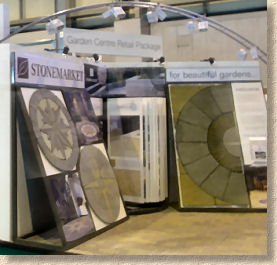
Tina also conceded that, as a brand, Stonemarket over recent years had been in danger of forgetting its origins as a firm favourite amongst garden centres and smaller builders' merchants. To redress this potential shortcoming, a whole new approach to supporting this class of retailed has been developed. Miniature displays, re-designed product packaging, a special 'retail brochure' and direct-to-home delivery with no stock commitment from the retailer are all intended to re-capture outlets that might have been tempted away by the sweet overtures from other suppliers. As you'd expect from StoneMarket, it is all very 'high end', aimed at the prestige market with impeccable styling and genuine élan.
Bradstone:
On first entering the hall, I walked straight past the Bradstone stand, uncertain as to just where it began. Even now, several days after the event, one word springs to mind when thinking back about this year's Bradstone stand: cluttered. There was too much going on in a relatively small space (not that it was any smaller than previous years), and no clear view. It all seemed to consist of metre-square sample panels haphazardly put together and then encumbered by all sorts of structures whose sole purpose seemed to be to act as obstacles to both sightlines and ease of passage.
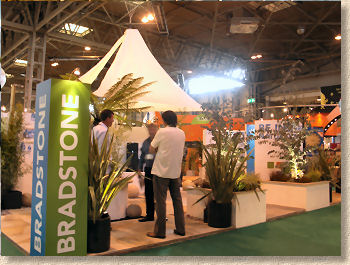
I had the benefit of getting it all explained to me by no less than three PR types and a marketing manager, and on reflection, they seemed more concerned about “the message” and the new products than they did about the overall perception. If ever there was a case of not being able to see the wood for the trees!
Starting with "the message", this centred on Bradstone's (and AI's) commitment to carbon labelling and sustainability, combined with a desire to offer a complete domestic paving and walling range encompassing both stone and concrete products, as flags, block pavers, setts, walling and copings.
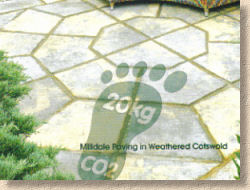
To be fair to Bradstone, I have never yet met a manufacturer with a greater root-and-branch commitment to what might be referred to as 'environmental issues'. From the energy-conscious practices amongst the production staff at their factories, to their work with The Carbon Trust , I really do get a sense that there is a company-wide culture at AI, and that is commendable. However, I'm not sure how much extra paving it will sell, especially given the current economic climate.
The second agenda item is the new products. The ones that will attract attention are those designed by a certain David Domoney, who, I'm told, is a TV celebrity gardener. Just how that qualifies anyone to design paving, I'm not sure, and with the painful memories engendered by the dabblings of an alternative "Celebrity Gardener" of an Hibernian flavour seared into my mind, it was with a sense of trepidation that I approached this latest oeuvre.
Mr Domoney has treated us to three offerings, all in wet-cast concrete, which might be termed the good, the bad and the strange. The good, which the Bradstonites have dubbed Woven , is very, very good. It's a variation on what we used to call Hopsack paving, relying a Cotswold buff main unit with a dark black 'knot'. Both components have a lovely hessian-like texture and the finished effect is highly attractive. Its main limitation is the lack of versatility: there's only one way to use it, and that's as shown. However, that should not be allowed to detract from the fact that it is eye-catching and is ideally suited to smaller courtyards and patios.
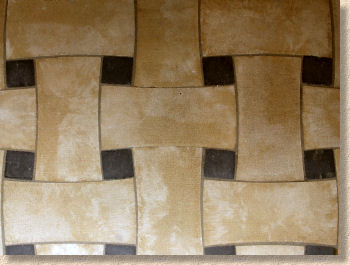
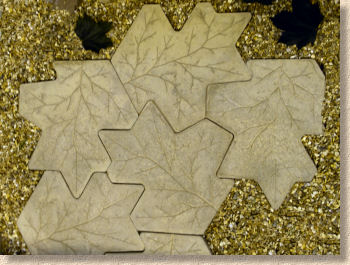
The bad is some monstrosity they've named Foliage . It's a cheesy, tacky leaf-shaped interlocking small flagstone that can be linked to cover a larger area or used as stand-alone stepping stones (or thrown straight into a skip). This is a perfect example of how wet-casting can go to the dark side. The really annoying thing about it is that it will sell. It's one of those 'impulse buy' items beloved of pensioners and the bewildered who visit the garden centre looking for crap to fill their lives. When you work out the cost per square metre, the shocking realisation is that it is more expensive than a quality paving such as the gorgeous Refinement . Someone, please, make it go away.
Finally, the strange is the intriguing Serenity paving, an almost square wet-cast flagstone with slightly convex and concave sides and a surface that emulates a wave-washed sand beach, all of which combines to create a sinuous, tactile paving that I still can't decide whether I like or not. The texture is interesting, and the concept is original, but the colour is too common (an un-inspiring buff) and the top of the ridges very quickly dirties and will abrade with time. There is potential here; a bit more work and this could be a good product, but this is not quite it.
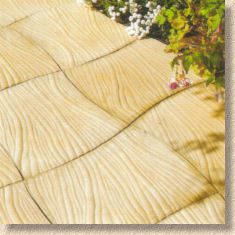
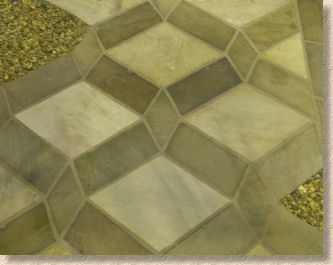
Let's move on to something more appetising. Optique is another damned clever idea, the sort of paving that might have been designed by Escher in his lunchtime, and is visually compelling. The idea is simple and the processing required is minimal: simply skew conventional rectangles, and there you have it. The choice of contrasting colours works well in this type of geometric pattern, but my only concern is one of scale. For me, the centre diamonds are too small in relation to the side pieces, and the result is a pattern that's overly busy. If that diamond was enlarged to, say, 750-900mm along the long axis, the effect would be more subtle, but no less compelling.
The only other new product of merit in natural stone is the aforementioned Refinement , a calibrated, sawn and blasted sandstone with a minimal chamfered edge. This could very easily be mistaken for the famed Highmoor yorkstone, with its steel grey background enriched with sweeping bands of iron-rich buffs, golds and oranges. The stone isn't unique to Bradstone: it was exhibited by another supplier at a show 18 months ago, but Bradstone have it in stock as 11.4m² project packs in 500/750/1000 x 500mm sizes, as well as the highly appealing 1000x200mm 'planks' that are more demurely referred to as 'Long Aspect' paving. If you're looking for a visually captivating natural stone, this is well worth considering.
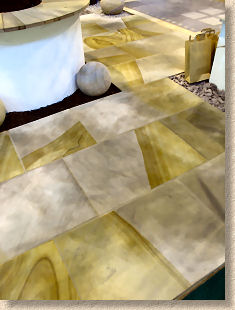
Bradstone, as a brand, has never really been the name that first springs to mind when considering block paving. Over the last couple of years or so, AI has had a deliberate policy of using Bradstone as the brand for all residential paving, be it flags, setts or block paving, but somehow the name remain synonymous with patio flagstones and walling. Getting folk to accept Bradstone as a serious player in the residential block paving market has been something of an uphill struggle. 2009 promises a renewed effort, with the product range being expanded to include a standard 200x100 budget product, a more upmarket tumbled paver ( Woburn Cobble ) and a new natural stone block paver for those customers looking for real class. Add to that the stunning StoneMaster blocks developed at sister company Charcon, and you have the basis of an eclectic range. Many block products will be pre-treated with the Bradstone Surface Protection , a new generation of Teflon-like sealants that you wouldn't know were there until you spill summat on the paving. And, as you'd expect from a company of Bradstone's stature, there are permeable Infilta versions of the main concrete blocks.
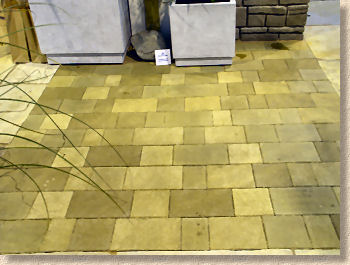
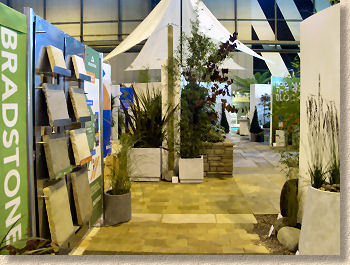
Unfortunately, it was very difficult to view any of these products on this over-decorated, confused stand. You were constantly bumping into other visitors, or having to move to let someone pass, and bear in mind previous comments regarding the unhealthy visitor numbers; there was no outstanding viewpoint that gave a reasonable perspective of the display. Indeed, the best views were obtained late on Monday evening, after closing time when the punters had left and I had the place to myself, but even then, I could find only two genuinely attractive view-lines, and one of these required me to crouch down to avoid the view being blocked by an over-sized tree fern.
Page 1 | Page 2 | Page 3 | Page 4 | | News Index Page


